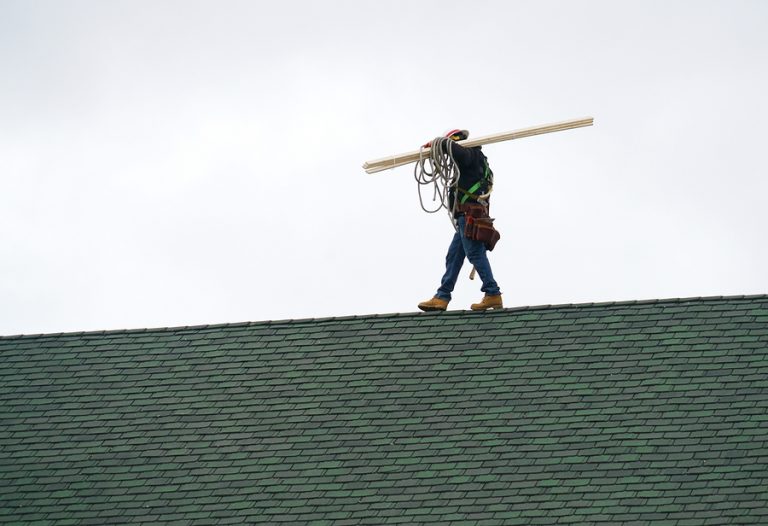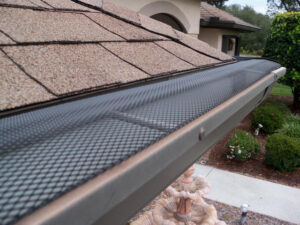Walking on typical roofs are dangerous. It is estimated that nearly 650 people per year die from falling off their roofs. Such accidents can be avoided for the most part if you take the proper precautions. Plus, if you have issues with balance or do not have the strength to properly stay up on a roof, then you should hire a professional to do whatever job you wanted to be completed on your roof.
Table of Contents
Why Go Up on the Roof?
That is a very good question. There needs to be a good reason why you are going up in the first place. Quite often, roof accidents happen because the reasons for going up are rather frivolous. This means you are not focused on what you are doing and all it takes is one distraction which may lead to injury or worse.
If you have a good enough reason to be on the roof, you will still need the strength and balance to go up the ladder, do the job, and come down the ladder. If you are mentally and physically fit, then you will need to be properly prepared to walk on your roof with maximum safety.
4 Essentials for Walking on the Roof
You will need four things to ensure the maximum amount of safety if you decide to step on your roof. By having all four things available, you can help maintain your balance even in tricky situations.
1. Have Proper Footwear
Arguably the most important thing you need is footwear that has rubber soles. The rubber will ensure a solid footing, so you can walk with more balance and confidence. Of course, you do not want to be overconfident when you are walking on the roof, but there will be considerably less danger when you choose a pair of rubber sole shoes.
2. Have the Right Harness
As good as your footwear may be, a harness will keep the worst from happening to you assuming it is secure. The harness attaches you to a roof bracket or equally secure part of the home such as a truss. By anchoring the harness in this manner, if you should fall, then you should only hit the roof and slide a little. Your pride may be hurt more than your body, but you will not fall off the roof which is the most important part.
If there is no roof bracket or similar part of the home that a harness can be attached, then you should get a long, strong rope and secure that to a big tree or other immovable objects on the other side of the home. Take up the slack so that if you do fall, the rope will stop you from reaching the ground. It’s time-consuming, but you will be thankful to have a harness if you do fall.
3. Ensure Ladder is Secure
You will need to place the ladder on level ground and ensure that the top of the ladder is no more than three feet above the edge of the roof. A good rule of thumb is to extend the ladder back from perpendicular one meter or yard for every four meters or yards of the ladder itself. In other words, if your ladder is 8 meters long, it should be 2 meters back from perpendicular. Next, secure the ladder using a cord or rope so that it does not move from side to side. This will keep you steady as you climb and descend the ladder.
Plus, you should have a spotter to ensure that you are safe. The spotter will help secure the ladder at the bottom and help guide you up or down if you need some assistance.
4. Wear the Proper Toolbelt
The toolbelt is most important because anything that you are taking up to the roof can be hung or strapped on your toolbelt. This is a better option compared to carrying a toolbox because you have both hands free. Plus, the toolbelt will help lower the center of gravity a bit, so you can walk with a little better balance depending on what you are carrying.
Before getting on the roof, be sure to balance out your toolbelt as much as possible. This means if you are taking a heavy tool on one side, try to match it with something of similar weight on the other. However, if you are only getting on the roof to clear away some debris and you do not need any tools, then you can forego the toolbelt.
Now that you have everything at the ready, the next step is when to go up the ladder to the roof. This means that certain conditions will have to be met before you make the climb.
Good Weather
A dry day will do with light winds. This means that the roof is free of moisture and the winds are light enough that you will not lose your balance. Cloudy or sunny doesn’t really matter as long as the roof itself is dry and the winds are light.
Mark Space Below the Roof
If you are working on a particular place on the roof, mark off the area below with ropes, tape, or other obstacles to ensure that no one will be hurt if you drop a tool or other item. If you move to another location, be sure to move the marked space down below.
Clear the Area
Whether you are covering the entire roof or just one space, clear the area first before doing anything else. This means that any twigs, leaves, and other items need to be removed so you can do your work. For many people, clearing the roof is the job that they are doing, so just be sure that where you walk is clear of any debris.
Learning how to walk on your roof properly will take a little time in terms of preparation and perhaps some money in getting the right shoes and equipment. But it is worth the investment to keep you safe and sound when you are walking on your roof. For more information, beaconbasingstokeroofing.co.uk also provide great roofing safety tips in their blog.
Founder of HandymanGuides.com and self-proclaimed “Mr. Fix-It”, Mike has countless years of experience building and tinkering with everything under the sun. He works as a local repair guy near Santa Monica, CA and when he’s not spackling drywall, he enjoys spending time with his wife and 2 daughters.








